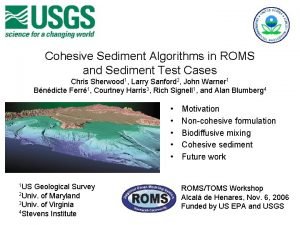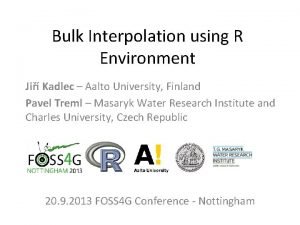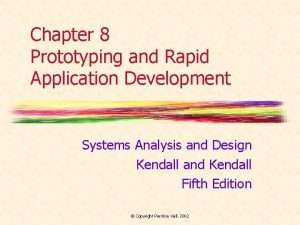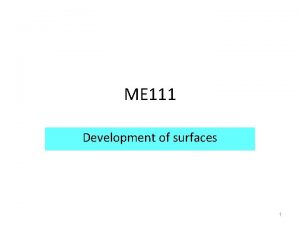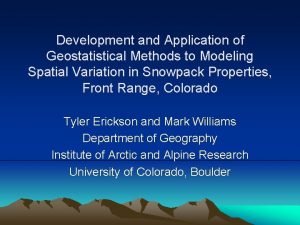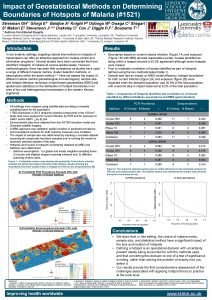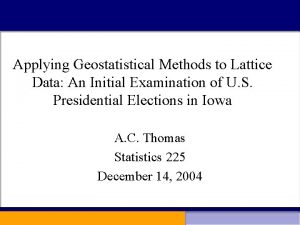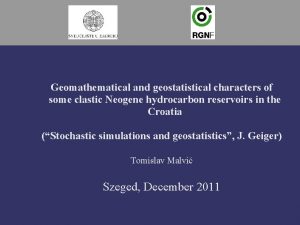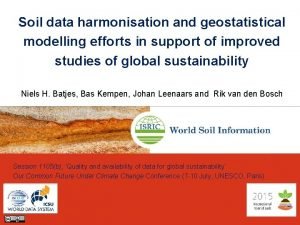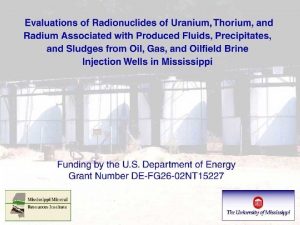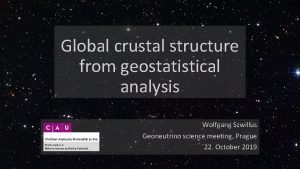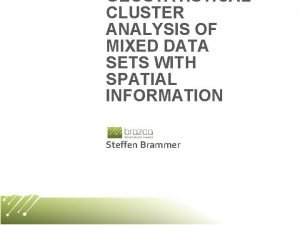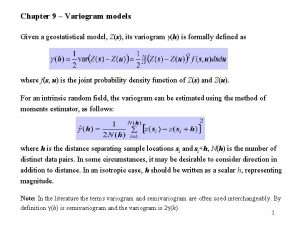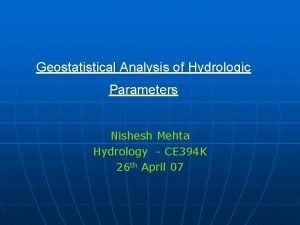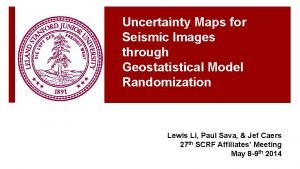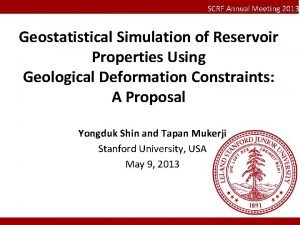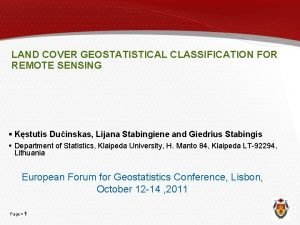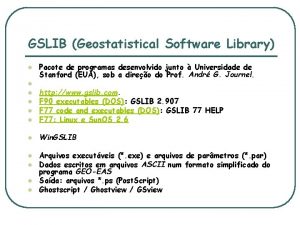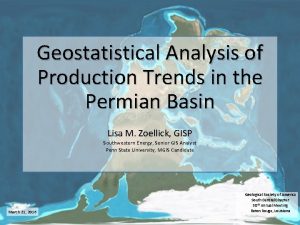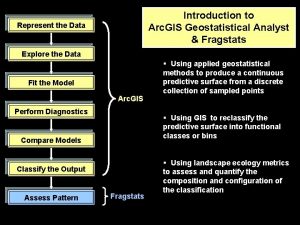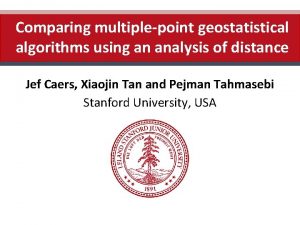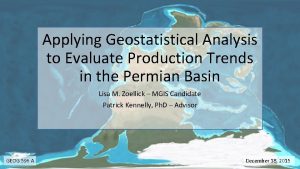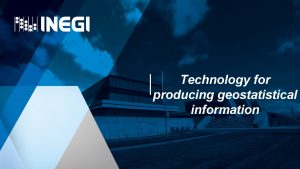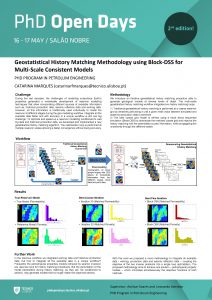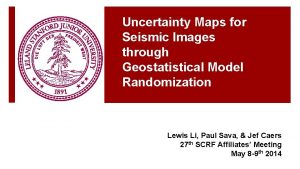Development and Application of Geostatistical Methods to Modeling



















![Deterministic Snow Depth Maps Constant Snow depth [m] 0 Linear 5 Nonlinear 10 Deterministic Snow Depth Maps Constant Snow depth [m] 0 Linear 5 Nonlinear 10](https://slidetodoc.com/presentation_image/33c3e266c9943db2646f8c8ef9ad71a0/image-20.jpg)





- Slides: 25

Development and Application of Geostatistical Methods to Modeling Spatial Variation in Snowpack Properties, Front Range, Colorado Tyler Erickson and Mark Williams Department of Geography Institute of Arctic and Alpine Research University of Colorado, Boulder

Mountain Snowpacks • Water source • Recreation • Habitat

Empirical Model Physically-based Model redistribution precipitation sublimation snowpack infiltration snowmelt

Snowpack Distribution • Physically-based models require spatially-distributed model inputs • Snow properties are typically measured at only a few locations (1 site per 1650 km 2) • How can we infer snow properties over large areas from limited measurements?

Spatial Correlation • Measurements in close proximity to each other generally exhibit less variability than measurements taken farther apart. • Assuming independence, when the data are spatial-correlated may lead to: 1. Biased estimates of model parameters 2. Biased statistical testing of model parameters • Spatial correlation can be accounted for by using geostatistical techniques

Snow Depth in Green Lakes Valley

Objectives • Identify significant auxiliary variables for predicting snow depth in an alpine valley • Estimate snow depth distributions at unsampled locations and/or times


Methodology Overview Linear Regression - Incorporates auxiliary variables - Significance testing Geostatistics - Spatial estimates - Incorporates spatial correlation Geostatistical with a Complex Mean

Regionalized Variable Modeling regionalized variable z(x) linear model deterministic component = m(x) stochastic component + e(x) variogram model

Spatial Modeling of Snow z(x) = m(x) + e(x)

Auxiliary Parameters z(x) • • • Elevation Slope Radiation Shelter Drift = m(x) + e(x)

“Linear” Model # of base functions base function coefficients Constant mean: Linear trend: Nonlinear trend: Base function coefficients (β) are optimized by solving a kriging system

Kriging System How do we determine the coefficients (b)? trend model variogram model unknowns measured data

Variogram Model • Used to describe spatial correlation 1 2 3 4 Variogram parameters (σ2 and L) are optimized by Restricted Maximum Likelihood

Significance Testing Compact model: Augmented model: H 0: β 2 = 0 Is β 2 significantly different from zero? • Sampling snow depth – length = 1000 m Is elevation a significant predictor of – spacing = 50 m snow depth? – # points = 21

Example cont… H 0 is TRUE 5% H 0 Rejected! H 0 H 5% 0 Not Rejected 5% H 0 rejected

Methodology Flowchart Measured data 7 (annual surveys) Variogram model 1 (exponential variogram) Trend model 3 (constant, linear, nonlinear) Auxiliary data 5 (elevation, slope, radiation, wind shelter, wind drifting) Variogram optimization (RML) Base function optimization (kriging) Estimate or simulation maps

z(x) = m(x) + e(x) Optimized Coefficients
![Deterministic Snow Depth Maps Constant Snow depth m 0 Linear 5 Nonlinear 10 Deterministic Snow Depth Maps Constant Snow depth [m] 0 Linear 5 Nonlinear 10](https://slidetodoc.com/presentation_image/33c3e266c9943db2646f8c8ef9ad71a0/image-20.jpg)
Deterministic Snow Depth Maps Constant Snow depth [m] 0 Linear 5 Nonlinear 10

Model Error Variograms z(x) = m(x) + e(x)

Snow Depth Maps 1999 best conditioned estimate of stochastic best estimate component 1999 best estimate of deterministic component snow depth [m] 0 5 model residual [m] 10 -5 0 5

Correlation to SNOTEL β 1 = 231 cm Developed Remaining from βs are ’ 98, ’ 00, ’ 01, obtained from’ 02, ’ 03 data (excludes ’ 99) multiyear modeling (’ 98, ’ 00, ’ 01, ’ 02, ’ 03) 111 m 2. 4 m 2 564 mm

Comparison to Regression Tree (1999 Dataset) Regression Tree Model Winstral et al. (2002)

GLV Summary • Used a spatially continuous, nonlinear model of the mean snow depth • Identified topographic parameters that are significant predictors of snow depth • Used external data (SNOTEL) to make a prediction without snow depth sampling
 Geostatistical
Geostatistical Geostatistical
Geostatistical Helen c erickson
Helen c erickson Dimensional modeling vs relational modeling
Dimensional modeling vs relational modeling Threat modelling web application
Threat modelling web application Indirect methods of contoring uses how many methods
Indirect methods of contoring uses how many methods Rapid prototyping model in software engineering
Rapid prototyping model in software engineering Online platform and application for content development
Online platform and application for content development Prototyping and rapid application development
Prototyping and rapid application development Advantages of throw away prototyping
Advantages of throw away prototyping What is fact finding in system analysis and design
What is fact finding in system analysis and design Agile methods for embedded systems development
Agile methods for embedded systems development Swot analysis of housekeeping department
Swot analysis of housekeeping department Development of surfaces
Development of surfaces How many levels does adm have?
How many levels does adm have? Sheet metal pattern development
Sheet metal pattern development Example of definition pattern of development
Example of definition pattern of development Dfd chapter 5
Dfd chapter 5 Linear quadratic function
Linear quadratic function Dfd chapter 5
Dfd chapter 5 Hpc application development
Hpc application development Oracle apex mobile application development
Oracle apex mobile application development Joint application development jad
Joint application development jad Advantages and disadvantages of multimedia
Advantages and disadvantages of multimedia Android wireless application development
Android wireless application development Data driven web applications
Data driven web applications
